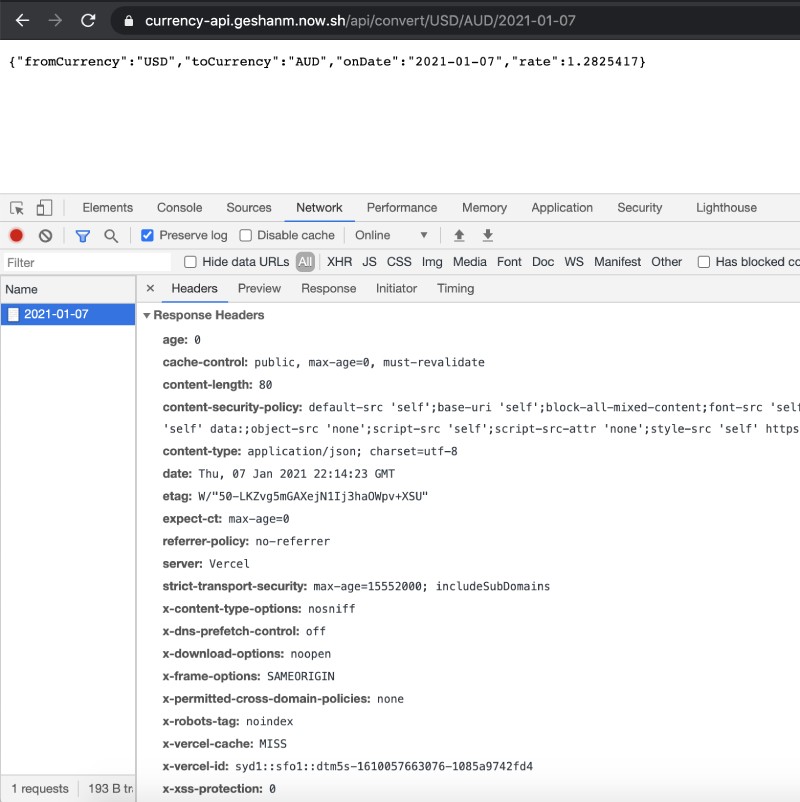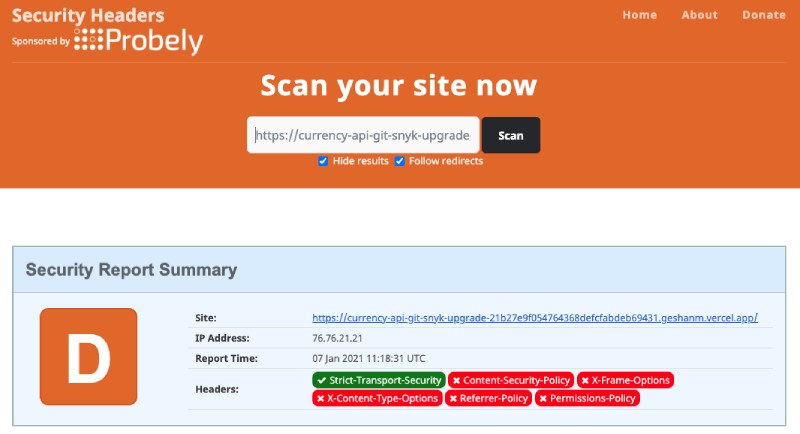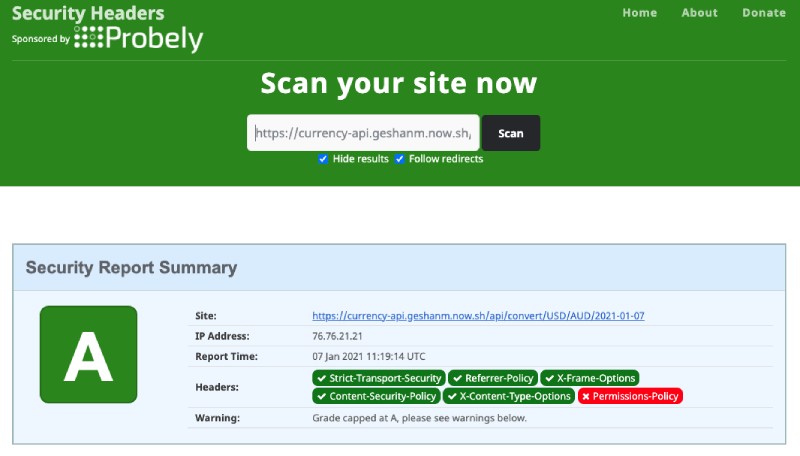Security is everyone’s responsibility. Express Helmet secures your Node.js application from some obvious threats. While writing a Node.js Express application, always use Helmet to safeguard your application or API from usual security risks like XSS, Content Security Policy, and others.
In this post, we will see how we can add Helmet to an existing API and how it bolsters the security of the application. Let’s get started!

Background Photo by Harley-Davidson on Unsplash
Table of contents #
- Web application security
- Example Express Js application
- Express without Helmet Js
- Express Helmet to the rescue
- Quick scan
- Conclusion
Web application security #
Web application security is a pretty vast topic, people have written books about it. For example, OWASP comes up with a yearly top 10 web application security risks where Injection (like SQL injection) and Cross-Site Scripting (XSS) usually make it into the top 10 list.
For example, with Node.js and MySQL you would want to use the MySQL2 library vs MySQL library because it supports prepared statements which can tackle SQL injection from the database level.
There would be a lot of other security things you would want to learn about depending on how sensitive your public-facing application and its related data is.
Handy OWASP cheat sheets #
If you want to get your hands dirty with some Security stuff they have a long list of Cheat Sheets to get started quickly. It includes cheat sheets from docker security to SQL injection prevention. You want to find something on security, chances are you will find a cheat sheet from OWASP on that topic.
Node.js Web application security #
Focusing on a web application built with Node.js and Express. A library like Helmet can help on setting the right response headers which are great for a more secure application. As Node.js has a built-in web server it is easier for controlling the HTTP response headers from Node.js itself than another web server like Apache or Nginx.
If you are using Koa you can use Koa Helmet to add important response headers.
In case you are using other languages do consider the options available found in the see also section of the Helmet js website.
For instance, there is a Secure Headers composer package for PHP, and for Django there exists a pip package called Django CSP.
Example Express Js application #
In this walkthrough, we will use the Currency API application which is open source. It is a simple currency converter proxy API that gives the exchange rate from one currency to the other for a given date.
I have used it for other examples too like the faster docker builds one. I have also used the same application for docker multi-stage build post. It is a simple API, let’s analyze the headers and security risks it poses without Helmet.
Express without Helmet Js #
Below is the screenshot of the Header for the Currency API Node.js Express app without Helmet hosted on Vercel:

One of the things that caught my attention is the x-powered-by response header. I don’t think it adds any value to the client by knowing it is an Express app. On the contrary, if an attacker finds out we are using an old version of Express, the attacker will try to exploit any known vulnerability. This header will be removed by Helmet.
Some more headers that would make the server secure that are missing are:
- Content-Security-Policy
- Strict-Transport-Security
- Expect-CT
- Referrer-Policy
- X-Content-Type-Options
At this juncture, let’s add Helmet js to our Currency API Express application as the next step.
Express Helmet to the rescue #
We have seen that some Response headers are crucial for security. To get these essential Response headers that instruct the browser to make our website more secure we will add Helmet Js to our application. We can add Helmet to our Express API app by simply installing it with:
npm instal --save helmetAfter that, we will require helmet in our index.js file and use it as a middleware like below:
const bodyParser = require('body-parser');
const helmet = require('helmet');
const exchangeRates = require('./src/exchangeRates');
const app = express();
app.use(helmet());You can view the changes as a pull request.
Helmet js with sane defaults #
As seen in the above code change, we have just used helmet with app.use(helmet()); without any extra configs added. The good thing about Express Helmet is that it automatically adds 11 sub middlewares with sane default configs.
This may be one of the reasons that even the Express.js security best practices for production recommends to use helmet js.
In addition to using Helmet, it also mentions securing cookies and other things.
Looking further, it's time to see what new response headers has Helmet added with the default configuration:

I had done a similar request last time but this time the x-powered-by response header is missing, thanks to Express Helmet. On the contrary, Helmet has added some new hearers which are very useful from a security point of view. We will see further, what these headers are and analyze 4 of the main ones.
Response headers for security #
By adding Helmet with default configuration we can see that some new response headers have been added to our Currency API app’s response:
- Content-security-policy is also known as CSP for short
- Expect-CT - CT is Certificate Transparency
- Referrer-Policy
- Strict-Transport-Security
Let’s discuss these 4 in a bit more detail:
Content Security Policy #
This header adds a layer of security by declaring which dynamic resources are allowed to load. It helps to mitigate Cross Site Scripting (XSS) and some forms of Click jacking too. You can read more about CSP.
For instance, with a strict CSP you can block images from other websites Following is the value of the Header given by Helmet as default:
content-security-policy: default-src 'self';base-uri 'self';block-all-mixed-content;font-src 'self' https: data:;frame-ancestors 'self';img-src 'self' data:;object-src 'none';script-src 'self';script-src-attr 'none';style-src 'self' https: 'unsafe-inline';upgrade-insecure-requestsWith the above policy, you can’t load a remote style as style-src is set to only self. Depending on your specific needs you can relax the policy. Have a look at the config options available on Express Helmet.
Expect Certificate Transparency #
Expect-CT as the name suggests checks for misuse of certificates. When a site enables the Expect-CT header, they are requesting that the browser check that any certificate for that site appears in public CT logs.
Browsers ignore the Expect-CT header over HTTP; the header only has an effect on HTTPS connections. So this is an explicit check by the browser that the given certificate for the website is a valid one as per public logs. Helmet adds expect-ct: max-age=0 meaning the browser should expect the certificate to be valid.
Referrer Policy #
In simple terms, referrer policy defines what data should be picked up from the referrer of the request. Helmet by default puts this to no data which means no part of the URL neither the origin nor the query string can be used on your website. Web.dev has a great piece on Referrer best practices with easy to understand graphical explanations. Helmet adds referrer-policy: no-referrer, which is pretty restrictive.
Strict Transport Security #
This response header tells the browser that the website needs to be accessed using HTTPS not HTTP. It has max-age and includeSubdomain directives. Max-age tells the browser the time in seconds the browser should remember that the website should only be accessed using HTTPS. The includeSubdomain directive which is optional, tells this rule applies to the site’s subdomains as well. Helmet adds the following:
strict-transport-security: max-age=15552000; includeSubDomainsSo it says that the website needs to be accessed via HTTPS for 180 days with its subdomains.
There are other headers added by Helmet like x-permitted-cross-domain-policies, X-Content-Type-Options, etc, they are a bit less important than the 4 mentioned above.
Quick scan #
You can do a quick scan of your website’s security headers on SecurityHeaders.com. Below is the before and after results of the Currency API Express application:
Before Express Helmet #

As seen above, without the use of Express helmet it is missing important HTTP response headers like Content-Security-Policy, Referrer-Policy, and others. The score for the website at this point is a "D".
After Express Helmet #

So from a poor "D" before Express Helmet, it jumped to a great "A" on Security Headers website.
This means Helmet is a must for every Node.js Express application for better security response headers.
If you are building an Express js application and thinking of putting it on production make adding Helmet js part of your go-to production checklist.
Conclusion #
Helmet is a great package for all Node.js Express applications.
It should be used with proper configurations so that the application is secure and still optimally permissive too.
There are other factors than just response headers and for better overall security we should focus also on other factors like secure cookies, the latest and secure versions of the packages, etc.